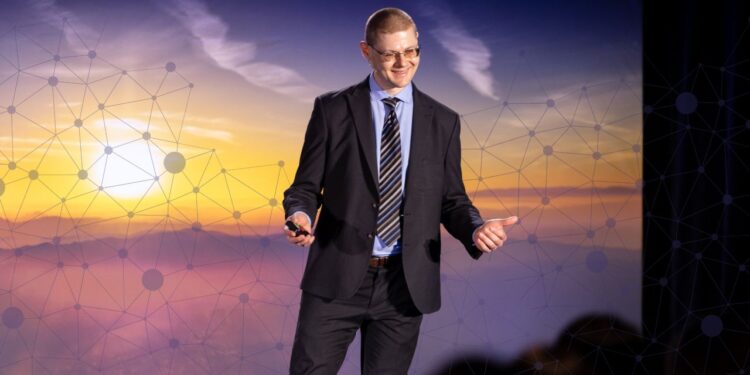- Generative AI enhances hybrid and remote work by enabling better idea generation, evaluation, and reducing the dependency on in-person collaboration.
- AI reshapes hiring by extending recruitment geographically and focuses on practical AI skills over certifications. White-collar roles increasingly value idea curation, while blue-collar jobs face immediate threats from automation.
- By embracing generative AI as a tool for evolution and disruption, both employees and leaders can navigate the complexities of this technological era, ensuring sustained growth and equity in an increasingly automated world.
This article is based on the Allwork.Space Future of Work Podcast episode featuring future-focused consultant and best-selling author Dr. Gleb Tsipursky. Click here to listen to the full episode.
Generative AI is revolutionizing industries by enabling unprecedented creativity and efficiency.
This advanced technology powers tools that create art, draft legal documents, and even design products, transforming how work gets done now and in the future.
According to PwC, 73% of executives believe AI will be key to their future business success.
Dr. Gleb Tsipursky, a leading figure in future-focused consulting and best-selling author, explained on the Allwork.Space Future of Work podcast just how hybrid and remote work are benefiting from generative AI. As the CEO of Disaster Avoidance Experts, Dr. Tsipursky provides an insightful perspective on the trends shaping workplace flexibility and productivity.
Defining Work Models
To plan for future business success, it’s important to be able to distinguish between work models.
Remote work is a broad term that applies to any work conducted outside the office—this could be from home, a café, or a coworking space.
On the other hand, distributed work involves working separately from teammates, which might include remote settings but also situations where colleagues are dispersed across various locations, even within company offices.
A substantial move toward hybrid work models is evident, particularly in the tech industry.
68% of high-growth organizations have enacted productivity anywhere workforce models, allowing employees to split their time between the office and remote locations.
For instance, industry giants like Nvidia and Microsoft offer significant flexibility, whereas companies like Apple and Xerox have opted for more structured hybrid models, according to Dr. Tsipursky.
Changing CEO Perspectives on the Office Return
A notable evolution in executive attitudes toward office returns has been captured in KPMG’s surveys of the world’s 100 largest companies. In 2023, 64% of CEOs predicted a full return to office work by 2026. However, a follow-up survey in 2024 shows a steep decline, with only 34% maintaining this expectation. This shift suggests increasing openness to flexible work arrangements, possibly influenced by advancements in generative AI.
Ways AI Will Shape the Future of Work
The use of AI by the workforce will do much more than enable flexibility, although that is a massively influential shift. Here are five ways Dr. Tsipursky predicts the evolving technology will transform the world of work.
1.Generative AI as a Driver of Flexibility
Generative AI is a pivotal enabler of flexible work environments. Dr. Tsipursky notes that organizations integrating AI into their operations find it easier to manage distributed teams.
For instance, generative AI aids in ideation and innovation processes, traditionally requiring in-person brainstorming sessions. AI can generate a broad array of ideas and also assist in evaluating these ideas, significantly streamlining the process.
Here’s how generative AI enhances innovation:
- Idea Generation: AI explores numerous possibilities, which might be beyond the scope of a single team’s capacity.
- Idea Evaluation: AI can simulate evaluations from various internal teams (marketing, product, legal) and external customer segments.
- Preparation of Materials: AI can draft business plans, marketing strategies, and pitch decks, thus freeing human team members to refine and select the most promising ideas.
2. Implications for Hiring Practices
Generative AI also reshapes hiring practices by expanding the geographic scope of recruitment. Companies are more willing to employ individuals outside their immediate vicinity, reflecting a broader trend toward flexibility.
The talent valued in the new AI-augmented work environment will evolve. Whereas idea generation has traditionally been a sought-after skill, the future will prize idea curation — selecting and refining the best outputs from AI-generated options.
Dr. Tsipursky addressed the current status of certifications in AI, pointing out the lack of well-validated programs. While badges and certifications exist, they often fail to carry significant weight due to their lack of validation.
Instead, companies are turning to practical tests to assess candidates’ proficiency with generative AI. For example, a common test might involve asking candidates to develop a new product and create a business and marketing plan using generative AI tools in just 15 minutes. This not only tests their technical skills but also their ability to apply AI in a real-world context.
Such hands-on assessments offer a clearer picture of a candidate’s capabilities compared to existing certifications.
3. The Dual Impact on Blue-Collar and White-Collar Jobs
According to Dr. Tsipursky, white-collar workers who master the use of generative AI are poised for success, while those who fail to adapt may find their roles redundant. Conversely, blue-collar jobs face a more immediate threat from generative AI and robotics. As automation technologies advance, roles such as truck driving and cashier positions are already being phased out.
For example, advancements in autonomous vehicles are gradually reducing the need for human truck drivers. Similarly, generative AI tools are increasingly taking over tasks in retail environments, from automated checkouts to inventory management.
Dr. Tsipursky emphasizes that while the pace of these changes varies, the trend is clear: jobs that involve repetitive, manual tasks are more susceptible to automation.
4.Societal Implications and Economic Disruption
Dr. Tsipursky also highlights the broader societal implications of rapid AI development. The faster AI evolves, the greater its potential for economic disruption and social impact. A swift transition could lead to significant job displacement, raising the need for solutions such as universal basic income to mitigate societal upheaval.
Moreover, the existential risks associated with AI, such as the potential for generative AI to evolve into harmful entities like computer viruses, cannot be ignored. Such risks call for a balanced approach to AI development, ensuring that technological advancements do not outpace our ability to manage their consequences.
One of the more optimistic views Dr. Tsipursky presented in our podcast conversation is the democratization of knowledge and education through generative AI. In developing countries, access to information and quality education has traditionally been limited.
Generative AI can level this playing field by providing personalized, high-quality educational resources to everyone, regardless of their socio-economic background. Rich kids currently benefit from personal tutors, but in the near future, generative AI can offer tailored instructional support to all students, potentially reducing educational disparities.
5.Strategic Integration of AI in Business
For businesses, the strategic integration of generative AI holds promise for enhanced productivity and flexibility. Companies can use AI to enable distributed work, allowing them to tap into a global talent pool and coordinate efforts more efficiently. This shift not only broadens hiring options but also makes a more inclusive and work environment.
Companies that successfully integrate generative AI stand to gain significant competitive advantages, particularly in industries like tech, where AI capabilities can drive innovation and operational efficiency. As Dr. Tsipursky advises, leaders should focus on equipping their workforce with the skills needed to harness AI effectively, which creates a culture of continuous learning and adaptation.


 Dr. Gleb Tsipursky – The Office Whisperer
Dr. Gleb Tsipursky – The Office Whisperer Nirit Cohen – WorkFutures
Nirit Cohen – WorkFutures Angela Howard – Culture Expert
Angela Howard – Culture Expert Drew Jones – Design & Innovation
Drew Jones – Design & Innovation Jonathan Price – CRE & Flex Expert
Jonathan Price – CRE & Flex Expert














